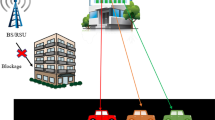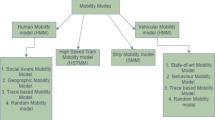Abstract
In this paper, we propose an optimization algorithm for RIS-assisted multiple-input single-output vehicle communication systems, Given a vehicle-to-vehicle user signal to interference plus noise ratio requirement, we optimize the transmit beamforming vector and phase shift matrix of RIS to obtain the maximum transmission rate of vehicle to infrastructure user. To deal with the coupled variables in the optimization problem, the alternate iterative algorithm is exploited to divide the original optimization problem into two sub-problems, each with a single variable. Moreover, the first-order Taylor expansion and the semidefinite relaxation methods are used to transform the nonconvex sub-problems into convex optimization problems. The simulation results are presented to validate the superiority of the proposed method compared to the benchmark schemes. Additionally, the simulation results also reveal that there exits an optimal vehicle speed under different path loss exponents so as to achieve the maximum transmission rate if the RIS is used by our proposed beamforming method.







Similar content being viewed by others
References
Zhang, Z. S., Wang, X., Zhang, C. T., & Lv, S. B. (2015). Massive MIMO technology and challenges. Scientia Sinica Informationis, 45(9), 1095–1110. https://doi.org/10.1360/N112015-00057
Zhang, S. W., & Liu, J. J. (2019). Ergodic capacity analysis on MIMO communications in internet of vehicles. Mobile Networks and Applications, 26(2), 1–17. https://doi.org/10.1007/s11036-019-01352-1
Zhu, Y. S., Mao, B. M., & Kato, N. (2022). Intelligent reflecting surface in 6G vehicular communications: A survey. IEEE Open Journal of Vehicular Technology, 3, 266–277. https://doi.org/10.1109/OJVT.2022.3177253
Dampahalage, D., Manosha, K., Rajatheva, N., & Latva-aho, M. (2020). Intelligent reflecting surface aided vehicular communications. In IEEE Globecom workshops (pp.1–6). https://doi.org/10.1109/GCWkshps50303.2020.9367569
Wu, Q., & Zhang, R. (2019). Intelligent reflecting surface enhanced wireless network via joint active and passive beamforming. IEEE Transactions on Wireless Communications, 18(11), 5394–5409. https://doi.org/10.1109/TWC.2019.2936025
Shen, H., Xu, W., Gong, S. L., He, Z. Y., & Zhao, C. M. (2019). Secrecy rate maximization for intelligent reflecting surface assisted multi-antenna communications. IEEE Communications Letter, 9, 1488–1492. https://doi.org/10.1109/LCOMM.2019.2924214
Zhu, Z., Xu, J., Sun, G., Wang, Y., & Hao, M. (2021). Secure beamforming design for RIS assisted SWIPT internet of things system. Journal on Communications, 42(4), 185–193. https://doi.org/10.11959/j.issn.1000−436x.2021060
Wang, J., Wang, H., Han, Y., Jin, S., & Li, X. (2021). Joint Transmit beamforming and phase shift design for reconfigurable intelligent surface assisted MIMO systems. IEEE Transactions on Cognitive Communications and Networking, 7(2), 354–368. https://doi.org/10.1109/TCCN.2021.3058665
Dai, J., Zhu, F., Pan, C., Ren, H., & Wang, K. (2022). Statistical CSI-based transmission design for reconfigurable intelligent surface-aided massive MIMO systems with hardware impairments. IEEE Wireless Communications Letters, 11(1), 38–42. https://doi.org/10.1109/LWC.2021.3120269
Wu, Q., & Zhang, R. (2019). Beamforming optimization for intelligent reflecting surface with discrete phase shifts. In ICASSP 2019–2019 IEEE international conference on acoustics, speech and signal processing (ICASSP), Brighton, UK (pp. 7830–7833). https://doi.org/10.1109/ICASSP.2019.8683145
Kong, X. P., Wang, Y., Zhang, L., Shang, Y. L., & Jia, Z. Y. (2022). Active and passive beamforming for IRS-aided vehicle communication. KSII Transactions on Internet and Information Systems, 17(5), 1503–1515. https://doi.org/10.3837/tiis.2023.05.011
Al-Hilo, A., Samir, M., Elhattab, M., Assi, C., & Sharafeddine, S. (2022). Reconfigurable intelligent surface enabled vehicular communication: Joint user scheduling and passive beamforming. IEEE Transactions on Vehicular Technology, 71(3), 2333–3234. https://doi.org/10.1109/TVT.2022.3141935
Makarfi, A. U., Rabie, K. M., Kaiwartya, O., Li, X., & Kharel, R. (2020). Physical layer security in vehicular networks with reconfigurable intelligent surfaces. In 2020 IEEE 91st vehicular technology conference (VTC2020-Spring) (pp.1–6). https://doi.org/10.1109/VTC2020-Spring48590.2020.9128438
Chen, Y., Wang, Y., Zhang, J., & Li, Z. (2020). Resource allocation for intelligent reflecting surface aided vehicular communications. IEEE Transactions on Vehicular Technology, 69(10), 12321–12326. https://doi.org/10.1109/tvt.2020.3010252
Shabir, M. W., Nguyen, T. N., Mirza, J., Ali, B., & Javed, M. A. (2023). Transmit and reflect beamforming for max-min SINR in IRS-aided MIMO vehicular networks. IEEE Transactions on Intelligent Transportation Systems, 24(1), 1099–1105. https://doi.org/10.1109/TITS.2022.3151135
Han, Y., Tang, W., Jin, S., Wen, C., & Ma, X. (2019). Large intelligent surface-assisted wireless communication exploiting statistical CSI. IEEE Transactions on Vehicular Technology, 68(8), 8238–8242. https://doi.org/10.1109/TVT.2019.2923997
Liang, L., Li, G., & Xu, W. (2017). Resource allocation for D2D-enabled vehicular communications. IEEE Transactions on Communications, 65(7), 3186–3197. https://doi.org/10.1109/TCOMM.2017.2699194
Guan, X., Wu, Q., & Zhang, R. (2020). Joint power control and passive beamforming in IRS-assisted spectrum sharing. IEEE Communications Letters, 24(7), 1553–1557. https://doi.org/10.1109/LCOMM.2020.2979709
Wang, P., Fang, J., Yuan, X., Chen, Z., & Li, H. (2020). Intelligent reflecting surface-assisted millimeter wave communications: joint active and passive precoding design. IEEE Transactionon Vehicular Technology, 69(12), 14960–14973. https://doi.org/10.1109/TVT.2020.3031657
Wang, J., Zhang, W., Bao, X., Song, T., & Pan, C. (2020). Outage analysis for intelligent reflecting surface assisted vehicular communication networks. In GLOBECOM 2020–2020 IEEE global communications conference, Taipei, Taiwan (pp. 1–6). https://doi.org/10.1109/GLOBECOM42002.2020.9322158
Xu, D. F., Yu, X. H., Sun, Y., Ng, D. W. K., & Schober, R. (2020). Resource allocation for IRS-assisted full-duplex cognitive radio systems. IEEE Transactions on Communications, 68(12), 7376–739468. https://doi.org/10.1109/TCOMM.2020.3020838
Grant, M., & Boyd, S. (2016). CVX: MATLAB software for disciplined convex programming. http://cvxr.com/cvx
Fang, F., Xu, Y., Pham, Q., & Ding, Z. (2020). Energy-efficient design of IRS-NOMA networks. IEEE Transactions on Vehicular Technology, 69(11), 14088–14092. https://doi.org/10.1109/TVT.2020.3024005
Guan, X., Wu, Q., & Zhang, R. (2020). Intelligent reflecting surface assisted secrecy communication: Is artificial noise helpful or not? IEEE Wireless Communications Letters, 9(6), 778–782. https://doi.org/10.1109/LWC.2020.2969629
Sidiropoulos, N., Davidson, T., & Luo, Z. (2006). Transmit beamforming for physical-layer multicasting. IEEE Transactions on Signal Processing, 54(6), 2239–2251. https://doi.org/10.1109/TSP.2006.872578
Wu, Q., & Zhang, R. (2020). Beamforming optimization for wireless network aided by intelligent reflecting surface with discrete phase shifts. IEEE Transactions on Communications, 68(3), 1838–1851. https://doi.org/10.1109/TCOMM.2019.2958916
Acknowledgements
This work is supported by National Natural Science Foundation of China (Nos. 61901196, 61701202), the open research fund of National Mobile Communications Research Laboratory, Southeast University (No. 2021D14), Future Network Scientific Research Fund Project (No. FNSRFP-2021-YB-35), Changzhou Sci & Tech Program (Nos. CJ20210070, CJ20235063), Changzhou Key Laboratory of 5G+ Indus-trial Internet Fusion Application (No. CM2023015)
Funding
Funding source of this work is supported by National Natural Science Foundation of China (No. 6190119 6, 61701202), the open research fund of National Mobile Communications Research Laboratory, Southeast University (No. 2021D14), Future Network Scientific Research Fund Project (No.FNSRFP-2021-YB-35), Changzhou Sci&Tech Program (No. CJ20210070), Changzhou Key Laboratory of 5G + Indus-trial Internet Fusion Application (No. CM2023015).
Author information
Authors and Affiliations
Contributions
Qian Li, Yu Wang and Lei Zhang wrote the main manuscript text, Yulong Shang and Ziyan Jia revised the grammar of the paper. All authors reviewed the manuscript.
Corresponding author
Ethics declarations
Conflict of interest
The authors have not disclosed any competing interests.
Ethical Approval
The authors declare that they have no known competing financial interest or personal relationships that could have appeared to influence the work reported in this paper.
Availability of Data and Materials
The corresponding author may provide the data and material used in the manuscript subjected to reasonable request.
Additional information
Publisher's Note
Springer Nature remains neutral with regard to jurisdictional claims in published maps and institutional affiliations.
Rights and permissions
Springer Nature or its licensor (e.g. a society or other partner) holds exclusive rights to this article under a publishing agreement with the author(s) or other rightsholder(s); author self-archiving of the accepted manuscript version of this article is solely governed by the terms of such publishing agreement and applicable law.
About this article
Cite this article
Li, Q., Wang, Y., Zhang, L. et al. System Design for Maximizing Rate in Vehicle Networking with Reconfigurable Intelligent Surface (RIS) Assistance. Wireless Pers Commun 134, 25–41 (2024). https://doi.org/10.1007/s11277-024-10864-3
Accepted:
Published:
Issue Date:
DOI: https://doi.org/10.1007/s11277-024-10864-3




